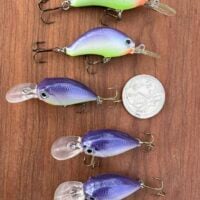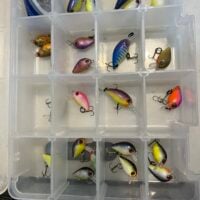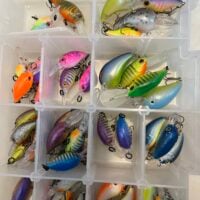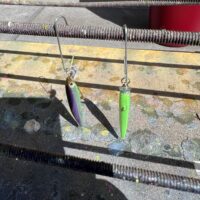Tom, during the spawn, do these little cranks produce better than mainstay presentations, such as casting and slow floating a jig/plastic past the fish’s face? Or suspending a jig/plastic under a shallow bobber? Casting micro crankbaits is not something I have done. Can’t help but think that if you are using them, then they must be ‘the deal’ at times.
Years ago I was looking for something different to try in my crappie fishing and found Yozuri’s Peanut Baits. These tiny balsa baits well absolute cain-raisers on shallow water bedded crappies. About all a guy had to do was land one of them within a couple feet of the bed and it was nailed. Just sitting there the fish would hit it. As far as the peanut baits being a better bait, I’d rank them right up with plastics. BUT, any of these small cranks are equally good when on a short, 3-4 foot, light line leader behind a drop shot weight “just” heavy enough to prevent blow back on a slow troll when crappies move out over deep water in the warmer summer months. Actually, a shad rap or other smaller shad crank of up to a #3 is a good crank for crappies then. The weights can be adjusted to the depth that the crappies are at, but slow is the key to the smallest cranks. Too fast and they’ll want to roll. The top two in the picture here are Yugoslavian Baits and no longer available here. They’re producers, hence the re-make on them. The other three are plastic, but they work as well as the balsa buddies.
I have a 3700 series shallow Plano box filled with peanut style baits as well as Yozuri Pin Minnows and the smaller sinking original Raps and host of other baits I have ordered up and painted. I’ll be ordering some lipless cranks soon that are small enough for crappies, about like the Ultra-Light Rap Shad of Rapala’s or the second to the smallest Big Eye shad bait that is Scheels branded. Since this purple over chartreuse is my go-to color in any crank used for crappies, these new ones will get the same treatment as these shown here.
An interesting observation on spawning crappies is that the fish on active beds are seldom hitting a bait to eat it. More often than not they’ll simply grab the bait and carry it outside of that magic ring around the nest and drop it, then they quickly swim back to the nest. I nipped the hook and barb off a jig and spent a whole morning watching this take place one spring day at the height of the crappie spawn.
Another observation is that the largest crappies will use deeper water that is adjacent to the usual shallow shoreline water used by the throngs of smaller fish for their spawning. The deeper water affords less light penetration [shade], more stable water temps and far less wave action.
Another observation is that crappies have a definite pecking order with the largest fish actually spawning ahead of the lesser fish time-wise and the largest fish getting the best spawning areas. Smaller crappies tend to get pushed into shallower water with less favorable or stable conditions so if you’re having trouble catching sizeable crappies during the spawn you’ve missed them, or you need to change locations and often this simply means to fish a bit deeper.
If I fish any time that relates to the spawn it’s likely to be when the largest fish start to move into the first decent break and stage to spawn. I try not to fish when the larger fish begin spawning as that’s where the genetics for future fishing are at. Once the larger fish are wrapping it up I’ll fish but turn the barbs on my hooks down so caught fish are returned as quickly as possible without harm to them.






